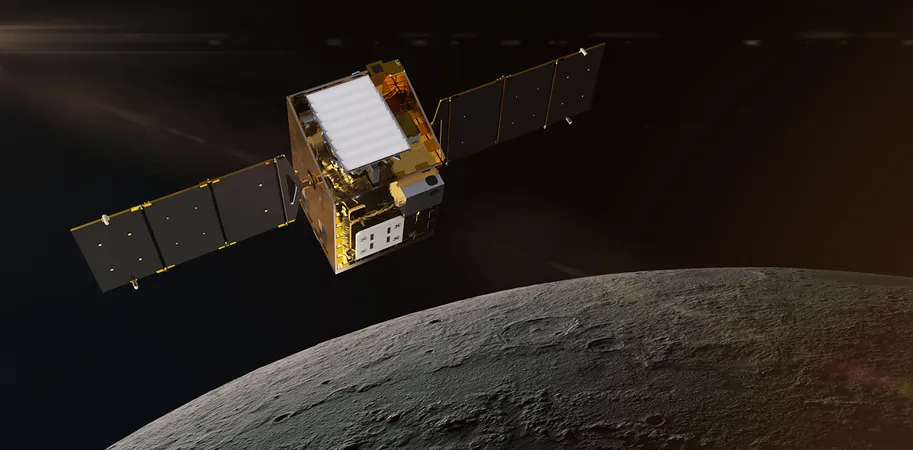
NASA's Lunar Trailblazer Mission Set to Transform Our Understanding of the Moon's Water by 2025
2024-12-29
Author: Mei
NASA is gearing up for an ambitious new chapter in lunar exploration with its Lunar Trailblazer mission, scheduled to launch alongside the PRIME-1 mission in January 2025. This dual mission aims to unlock the secrets of water on the Moon's surface, specifically at the lunar south pole, and pave the way for future human exploration.
As we await the upcoming Artemis II mission, which is expected to return astronauts to the Moon by April 2026—marking the first crewed lunar expedition since Apollo 17 in 1972—Lunar Trailblazer promises to provide crucial insights that could make lunar habitation a reality. Artemis II will utilize NASA's Space Launch System, complemented by the Orion spacecraft, to carry a crew of four around the Moon.
Dual Missions for a Dual Purpose
Before humans set foot on the Moon once again, NASA will send out the PRIME-1 mission to scout the lunar surface for potential resources. The mission includes advanced instruments designed to investigate water and the chemical makeup of lunar soil.
PRIME-1 will host two critical instruments: the Regolith and Ice Drill for Exploring New Terrain (TRIDENT), which will extract soil samples up to 3 feet deep, and the Mass Spectrometer for Observing Lunar Operations (MSOLO), which will analyze these samples.
Joining PRIME-1 on the same Falcon 9 rocket will be Lunar Trailblazer, a mission developed as part of NASA's Small, Innovative Missions for Planetary Exploration (SIMPLEx) initiative. This cost-effective approach allows the agency to conduct high-risk scientific explorations at a fraction of the usual cost—Lunar Trailblazer has a budget of $80 million, significantly lower than traditional missions.
A New Era for Small Satellites
The emergence of small satellites, or SmallSats, has revolutionized space exploration. These devices enable targeted measurements and can function as part of a constellation, providing high-resolution data of celestial bodies. Lunar Trailblazer leverages this technology, utilizing commercial off-the-shelf components to further reduce costs while maintaining mission efficacy.
The knowledge gained from such missions not only enhances our understanding of the Moon but also has broader implications for comprehending the origins of our solar system.
Unraveling the Mysteries of Lunar Water
Water has long captivated scientists' imaginations, with its presence on the Moon first hinted at by the Clementine mission in the 1990s. Subsequent missions, such as the Lunar Reconnaissance Orbiter and India's Chandrayaan-1, confirmed and expanded these findings, revealing intricacies about water's distribution on the Moon.
Lunar Trailblazer aims to delve deeper into how sunlight and shadow affect the state of water on the lunar surface. Equipped with the Lunar Thermal Mapper, it will measure temperature fluctuations, while the High-resolution Volatiles and Minerals Moon Mapper will analyze how lunar rocks interact with light to differentiate liquid from ice water.
The Science Behind Water's Origins
Understanding lunar water entails unraveling its origins. Some scientists theorize it may have originated from the Moon's mantle, gradually permeating the surface through geological processes. Alternatively, water might have arrived via asteroids and comets or been formed through chemical reactions initiated by solar wind particles.
Lunar Trailblazer is set to provide crucial data that could confirm these theories by examining the physical and chemical states of water at different times throughout the lunar day, which lasts approximately 29.5 Earth days.
What Lies Ahead
With the Lunar Trailblazer mission, researchers hope to piece together the complex puzzle of lunar water. This mission could lead to groundbreaking findings that not only affect our understanding of the Moon but also have significant implications for future human colonization and space exploration beyond Earth. Will we finally unlock the Moon’s secrets and make sustained lunar presence possible? Stay tuned as this thrilling adventure unfolds!
 Brasil (PT)
Brasil (PT)
 Canada (EN)
Canada (EN)
 Chile (ES)
Chile (ES)
 Česko (CS)
Česko (CS)
 대한민국 (KO)
대한민국 (KO)
 España (ES)
España (ES)
 France (FR)
France (FR)
 Hong Kong (EN)
Hong Kong (EN)
 Italia (IT)
Italia (IT)
 日本 (JA)
日本 (JA)
 Magyarország (HU)
Magyarország (HU)
 Norge (NO)
Norge (NO)
 Polska (PL)
Polska (PL)
 Schweiz (DE)
Schweiz (DE)
 Singapore (EN)
Singapore (EN)
 Sverige (SV)
Sverige (SV)
 Suomi (FI)
Suomi (FI)
 Türkiye (TR)
Türkiye (TR)
 الإمارات العربية المتحدة (AR)
الإمارات العربية المتحدة (AR)